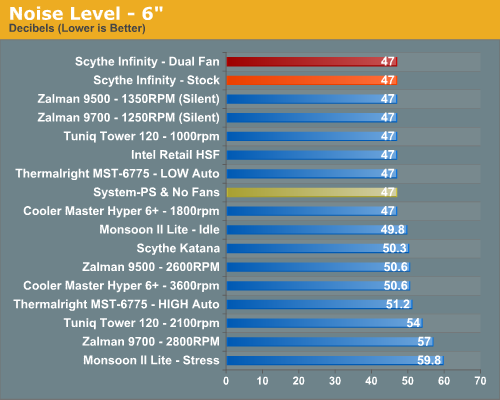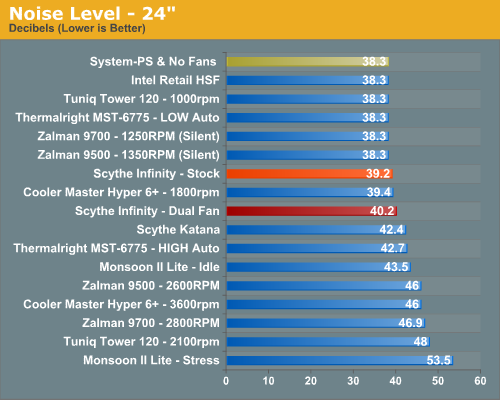Scythe Infinity: 5 Heatpipes and Silent 120mm Fan
by Wesley Fink on February 26, 2007 12:05 AM EST- Posted in
- Cases/Cooling/PSUs
Noise
For many enthusiasts upgrading cooling the goal is maximum stable overclock, and they will live with the inconvenience of a louder system. For other users silence is the most important factor, and these users will forgo maximum overclocking if this increase system noise levels. In general the Zalman 9500 and 9700 can be considered very quiet, but performance of either cooler is not standout against the competition - at least where noise is concerned.
To test idle and load noise levels, a Zalman Fan Mate 2 fan controller was used to dial in the lowest and highest fan speeds the fan could achieve. The difference in noise levels between low and high were negligible with the Scythe 120mm fan, so only high levels, which are generally below the system noise floor are reported. Tests were also run with a push-pull dual fan setup using two Scythe 120mm silent fans. These results are reports in the noise graphs as Dual Fan.
There are virtually no power supplies that do not have a fan. While Zalman and a few others do make a few expensive fanless power supplies, we have not seen a fanless unit larger than 500W, or one that would be used for seriously overclocking a system. With that in mind the noise level of the system with all fans turned off except the power supply was measured. The power supply used for the cooling test bed was the OCZ PowerStream 520, which is one of the quieter of the high performance power supplies. The noise level of the power supply was 38.3dB from 24" (61cm) and 47dB from 6" (152mm). The measured noise level of the test room is 36.4dB, which would be considered a relatively quiet room with a noise floor slightly below the OCZ PowerStream 520 PSU.


Measured noise levels in this chart should be considered worst case. Measurements were taken with an open side of a mid tower case 6" from the open HSF and 24" from the open HSF. Real world would be a completely closed case with a further reduction in noise.
The low-noise results with the Scythe Infinity are truly impressive. The stock single fan configuration scored some of the lowest noise results we have tested so far, generally remaining at or near the noise floor at both measurement distances. Even more impressive were the results with a dual-fan push-pull configuration. Noise results barely increased with two fans, again remaining at or near the system noise floor. Considering the Scythe matched our highest Tuniq overclocking results when running two fans, this is very impressive silence.
As already pointed out, any 120mm x 25mm fan should be mountable on the Infinity with a set of Scythe fan wires. The shipping fan is 1200 RPM and selected for silence. It's hard to complain about the noise measurements with this fan - single or dual. However, if you have a favorite silent fan or performance 120mm fan it should mount and work fine on the Scythe Infinity.
While the Scythe matched the Tuniq in overclocking and tied for the best OC with an air cooler, it is clearly the winner in silence at high speeds. This is true whether you run a single stock fan or dual silent fans. The Infinity is certainly bulky, as are most effective heatpipe towers, but fans of low noise cooling should definitely add the latest Infinity to their shopping list.
For many enthusiasts upgrading cooling the goal is maximum stable overclock, and they will live with the inconvenience of a louder system. For other users silence is the most important factor, and these users will forgo maximum overclocking if this increase system noise levels. In general the Zalman 9500 and 9700 can be considered very quiet, but performance of either cooler is not standout against the competition - at least where noise is concerned.
To test idle and load noise levels, a Zalman Fan Mate 2 fan controller was used to dial in the lowest and highest fan speeds the fan could achieve. The difference in noise levels between low and high were negligible with the Scythe 120mm fan, so only high levels, which are generally below the system noise floor are reported. Tests were also run with a push-pull dual fan setup using two Scythe 120mm silent fans. These results are reports in the noise graphs as Dual Fan.
There are virtually no power supplies that do not have a fan. While Zalman and a few others do make a few expensive fanless power supplies, we have not seen a fanless unit larger than 500W, or one that would be used for seriously overclocking a system. With that in mind the noise level of the system with all fans turned off except the power supply was measured. The power supply used for the cooling test bed was the OCZ PowerStream 520, which is one of the quieter of the high performance power supplies. The noise level of the power supply was 38.3dB from 24" (61cm) and 47dB from 6" (152mm). The measured noise level of the test room is 36.4dB, which would be considered a relatively quiet room with a noise floor slightly below the OCZ PowerStream 520 PSU.


Measured noise levels in this chart should be considered worst case. Measurements were taken with an open side of a mid tower case 6" from the open HSF and 24" from the open HSF. Real world would be a completely closed case with a further reduction in noise.
The low-noise results with the Scythe Infinity are truly impressive. The stock single fan configuration scored some of the lowest noise results we have tested so far, generally remaining at or near the noise floor at both measurement distances. Even more impressive were the results with a dual-fan push-pull configuration. Noise results barely increased with two fans, again remaining at or near the system noise floor. Considering the Scythe matched our highest Tuniq overclocking results when running two fans, this is very impressive silence.
As already pointed out, any 120mm x 25mm fan should be mountable on the Infinity with a set of Scythe fan wires. The shipping fan is 1200 RPM and selected for silence. It's hard to complain about the noise measurements with this fan - single or dual. However, if you have a favorite silent fan or performance 120mm fan it should mount and work fine on the Scythe Infinity.
While the Scythe matched the Tuniq in overclocking and tied for the best OC with an air cooler, it is clearly the winner in silence at high speeds. This is true whether you run a single stock fan or dual silent fans. The Infinity is certainly bulky, as are most effective heatpipe towers, but fans of low noise cooling should definitely add the latest Infinity to their shopping list.










39 Comments
View All Comments
dtanner - Monday, February 26, 2007 - link
By keeping the tower short, you are keeping the mass of the tower closer to the mobo and thus reducing the stress on the push pins. As another poster has stated, with this much mass I would definitely spend the extra $10 and get the UNIVERSAL RETENTION KIT "SCURK1".chienpourri - Monday, February 26, 2007 - link
Juste a suggestion, Scyte sells a UNIVERSAL RETENTION KIT "SCURK1" that anyone can find for around 10$, it comes with a backplate and everything. As the reviewer said, I would feel very uncomfy sitting the Infinity with only brackets... However using this kit it would fix the problem. The only downside I can find is the increased cost, but 10$ for security sounds good to me!orion23 - Monday, February 26, 2007 - link
Yeah...That!orion23 - Monday, February 26, 2007 - link
Hi!Great test guys!
I love how Anandtech started testing and reviewing other PC components.
You guys are doing great so far! Keep them coming...
And don't forget Power Supply Units!
Calin - Monday, February 26, 2007 - link
I find it somewhat to be understood - as the air would flow worse inside the cooler, part of it will flow out of it using the lateral spaces - as such, contributing very little or not at all to cooling.I wonder how much would single fan cooling improve if the air flow would be restricted in escaping by the sides. If so, what the performance would be with a push-pull configuration and lateral restrictions on air movement (escape)?
Jjoshua2 - Monday, February 26, 2007 - link
What I want to see is a more head to head test, with either the Tuniq using fans at the Infinity noise level, or the Infinity getting two higher powered fans, to see which wins.What I am interested in is the best performing silent/near silent fan & heatsink combo.
But overall, I liked the article thanks!
Wesley Fink - Monday, February 26, 2007 - link
We appreciate your suggestion, but we make every effort to test CPU coolers as they are packaged if at all possible. It would be a massive effort to try to go through an assortment of fans, find those singles and pairs that noise match and then replace fans supplied with the coolers with these matched singles and pairs. HSFs like Zalman have embedded fans which can't be swapped, and many top coolers use fan sizes with more limited selections than the 92mm or 120mm fan sizes.You have an interesting idea for an article on silent cooling, but it does go beyond the bounds of benchmarking and comparing performance of CPU coolers.
crimson117 - Monday, February 26, 2007 - link
What is the ambient temperature in the room during testing?Does the room get hotter after a few hours of testing, perhaps skewing temperatures higher for models tested at the end of the day?
Wesley Fink - Monday, February 26, 2007 - link
The ambient temperature of the room is 69F (21C) and is reasonably consistent. When running many computers in benchmarking the temperature may rise to 75F, but we check the temperature and turn off other systems during cooler testing.